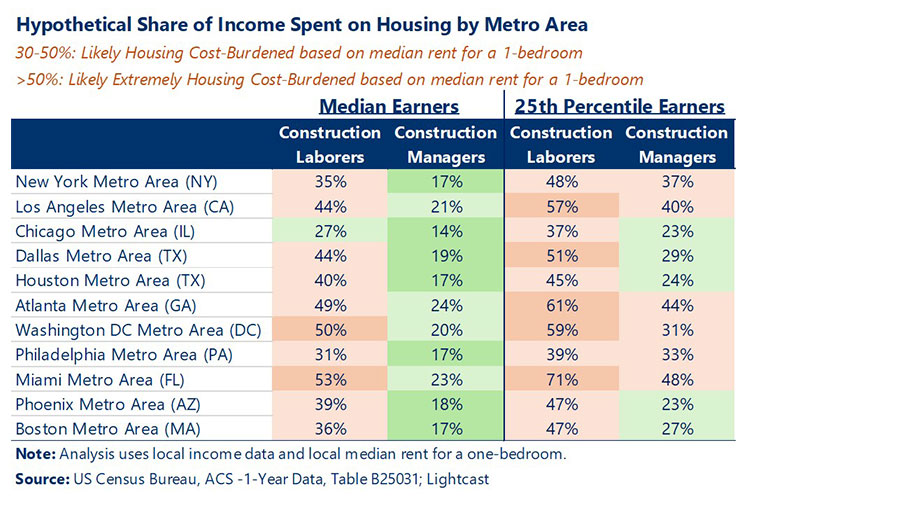- Navigator
- Real Estate Development and Housing

Economic development organizations (EDOs) play a critical role in shaping the economic landscape of their communities and lay the foundation for long-term prosperity by helping businesses start, grow, and create new jobs. To better accomplish these goals, EDOs also have a strategic interest in supporting affordable housing development.
While the development of affordable housing is complex and expensive, EDOs are well-positioned to help other local entities boost supply, and in the long term, benefits outweigh the costs.
How Does Affordable Housing Support the Mission of EDOs?
Attracts and Retains Talent
Affordable housing attracts a more diverse talent base, including younger workers or workers with skills for essential but often lower-paying jobs (e.g., janitors, postal service workers, healthcare technicians, laborers, etc.).
In our research for clients across the country, we find that many workers cannot afford to live near their jobs. These workers face long commutes and high transportation costs. As housing costs increase faster than paychecks, this challenge will only worsen. Workers facing a housing cost burden may seek jobs in more affordable locations, and workers searching for new jobs may be reluctant to move to high-cost job markets.
Attracts Businesses
Housing market recovery is a key factor driving site selection trends in 2025. Affordable housing reduces labor costs, contributes to quality of life, and attracts skilled labor — all key factors businesses consider when deciding where to locate.
Creates Jobs and Economic Activity
Any new housing development generates jobs for those directly involved in the construction phase and for long-term property managers and maintenance staff.
New housing development also indirectly creates jobs. New residents generate more demand for grocery stores, restaurants, childcare centers, retail stores, and other local businesses.
While resident spending can help stimulate the economy, 48.2% of all renters and 23.1% of all owners in the US are housing cost-burdened, according to the US Census Bureau’s 2023 ACS 1-Year Estimates. This means they spend more than 30% of their income on housing, leaving little disposable income for other essential and discretionary spending.
Additional affordable housing helps these households by keeping more money in their pockets, which benefits the local economy and supports workers of local businesses.
Improve Economic Stability
Housing instability is closely related to employment stability. Workers who lose their homes are 11 to 22 percentage points more likely to lose their jobs. The availability of stable, high-quality, and affordable housing generates long-term economic mobility benefits for residents. Affordable housing can help EDOs ensure that investment from economic development efforts is equitably distributed and benefits all residents.
How Do Housing Costs Impact Where Workers Can Live?
The primary impact of high housing costs is that workers who provide essential services often cannot afford to live near their workplaces. As you can see in this example, construction laborers face a housing cost burden in nearly every large metro area except Chicago.
Accessible data for this table
Workers not tied to their location may benefit from moving somewhere with more competitive wages relative to the cost of housing. However, moving will likely be a financial challenge for relatively low-wage workers.
The cost of living will also be a concern for entry-level workers. While a construction manager earning median wages does not face a housing cost burden in large metro areas, a first-year construction manager will likely earn less than the median wage. This may push young workers into more affordable areas with longer commutes.
Although this sample of data only covers construction workers, the concept applies to various occupations.
How Should EDOs Get Involved in Affordable Housing Development?
The importance of affordable housing to economic development efforts is evident and EDOs are well-positioned to get involved. Examples include:
- Promoting mixed-income developments
- Advocating for zoning or policy reform
- Facilitating employer-assisted housing programs
- Studying the housing market
- Identifying funding
- Leveraging connections with local employers
If your community is looking to better understand its housing needs or is ready to develop actionable strategies to address them, Camoin Associates offers unparalleled expertise in housing studies, market analyses, and strategic planning. Contact us to learn more about how we can support your goals.
📍 Related Articles:
- Home Sweet Home: The Puzzle of Modern Housing Demand
- Overcoming NIMBYism in Affordable Housing Development
- How to Encourage Construction of ‘Missing Middle’ Homes in Rural America
- Demystifying Deed-Restricted Affordable Homeownership: Is it Right for Your Community?
- How the State of Maine Has Responded to Its Housing Crisis
Accessible Data
Hypothetical Share of Income Spent on Housing by Metro Area
Numbers between 30-50% means the worker would likely housing cost-burdened based on median rent for a 1-bedroom home
Numbers over 50% mean the worker would likely extremely housing cost-burdened based on median rent for a 1-bedroom home
Construction Laborers, Median Earners
New York Metro Area: 35%
Los Angeles Metro Area: 44%
Chicago Metro Area: 27%
Dallas Metro Area: 44%
Houston Metro Area: 40%
Atlanta Metro Area: 49%
Washington DC Metro Area: 50%
Philadelphia Metro Area: 31%
Miami Metro Area: 53%
Phoenix Metro Area: 39%
Boston Metro Area: 36%
Construction Laborers, 25th Percentile Earners
New York Metro Area: 48%
Los Angeles Metro Area: 57%
Chicago Metro Area: 37%
Dallas Metro Area: 51%
Houston Metro Area: 45%
Atlanta Metro Area: 61%
Washington DC Metro Area: 59%
Philadelphia Metro Area: 39%
Miami Metro Area: 71%
Phoenix Metro Area: 47%
Boston Metro Area: 47%
Construction Managers, Median Earners
New York Metro Area: 17%
Los Angeles Metro Area: 21%
Chicago Metro Area: 14%
Dallas Metro Area: 19%
Houston Metro Area: 17%
Atlanta Metro Area: 24%
Washington DC Metro Area: 20%
Philadelphia Metro Area: 17%
Miami Metro Area: 23%
Phoenix Metro Area: 18%
Boston Metro Area: 17%
Construction Managers, 25th Percentile Earners
New York Metro Area: 37%
Los Angeles Metro Area: 40%
Chicago Metro Area: 23%
Dallas Metro Area: 29%
Houston Metro Area: 24%
Atlanta Metro Area: 44%
Washington DC Metro Area: 31%
Philadelphia Metro Area: 33%
Miami Metro Area: 48%
Phoenix Metro Area: 23%
Boston Metro Area: 27%
Note: Analysis uses local income data and local median rent for a one-bedroom home.
Sources: US Census Bureau, ACS 1-Year Data, Table B25031, and Lightcast




